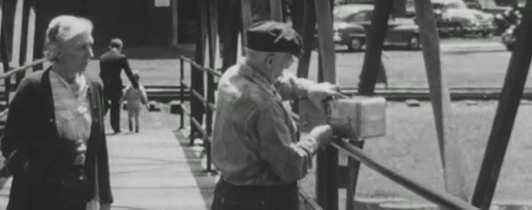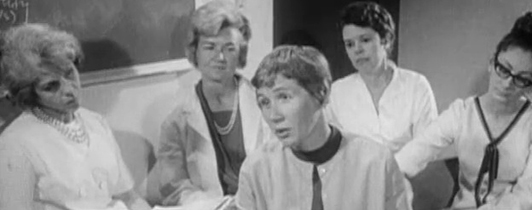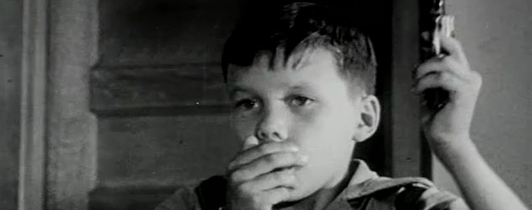Explore
Browse Guide | Subjects | Credits
Related Materials
Guide to Tropical Disease Motion Pictures
Public Health Service Film Guide

The National Library of Medicine’s Historical Audiovisuals Collection (HAV) is one of the most widely used sets of historical films in the world. The collection receives hundreds of research and reference requests annually. Of these requests, a significant percentage concerns material on mental health and disease, an area in which the collection is particularly strong. This Guide to Mental Health Motion Pictures is designed to aid patrons in identifying titles relevant to their interests and research.
The guide contains references to nearly 200 films and videorecordings produced from the 1930s up to and including 1970. Most deal with mental or psychiatric disorders as defined or recognized at the time the films were produced, as well as their corresponding causes and treatments. Some films focus on improving mental attitudes and thus overall health.
As noted in the essay to NLM's film site, The Public Health Film Goes to War (https://www.nlm.nih.gov/hmd/digicolls/phfgtw/index.html), motion pictures designed to educate in this era often followed a formula: "Typically, the screen images, and theatrical dialogue (if any), were accompanied by the voice of an authoritative male narrator-sometimes disembodied, sometimes onscreen-who directly addressed the audience, using the rhetoric of science and reason to persuade. . . ." This voice shows up in the mental health films as well, at times representing a medical professional or institutional administrator, at other times a government or military official, or a person associated with the pharmaceutical industry. Other cinematic approaches are also used: some films are simply recordings of interviews between a psychiatrist and a patient, with no voice-over narration; a few capture discussion panels; and still others are staged dramas.
The mental disorders found in these productions include anxiety, depression, psychosis, schizophrenia, substance abuse, and bipolar, dissociative, and personality disorders. Some films also consider as mental disorders topics that are not so classified today, such as alcoholism, homosexuality, and marital or maternal dissatisfaction. Therapies and treatments include psychiatric interviews, counseling and talk therapy, electro-convulsive therapy, frontal lobe surgery (lobotomy), pharmaceuticals, art therapy, residential treatment programs, and community-based treatment programs.
The audiovisuals also address doctor-patient and nurse-patient relations, child development, and parent-child interactions. There are several titles dealing with behavior or conditioning in animals, which informs scientific understanding of human behaviors, as well as rehabilitation of injured individuals, in which mental health is one focus of the treatment.
Materials range from ideological, documentary, educational, and training films to military-produced titles designed to explain the psychological impact of war and fear on soldiers.
The films address diverse audiences, including health professionals, scientists, law enforcement personnel, and the general public.
For each item, the guide includes the following information:
- Title
- Date of publication
- Running time
- Conditions/Therapies
- Names
- Abstract
- Link to the full catalog record in NLM’s online catalog, LocatorPlus
Notable Titles and Content Areas
- The Day Hospital (1940) and other titles portraying day-to-day life in community-based housing and mental health treatment centers.
- Recent Modifications of Convulsive Shock Therapy (1941), one of several titles depicting or discussing electro-convulsive therapy.
- Prefrontal Lobotomy in the Treatment of Mental Disorders (1942), a film demonstrating a prefrontal lobotomy procedure performed by Walter Freeman and James Watts, pioneers of the so-called “ice-pick lobotomy.”
- Combat Exhaustion (1943), one of several U.S. military-produced films dealing with combat fatigue and exhaustion, and what has come to be called post-traumatic stress disorder.
- Let There Be Light, a 1946 film by director John Huston that the Pentagon kept from public distribution until the 1980s because of its frank depiction of psychological trauma among combat veterans. In 2010, this film was named to the National Film Registry, which documents films of significant cultural, historical, or aesthetic value.
- Man to Man (1954), a film that portrays conditions in a progressive state psychiatric institution in the 1950s, and in particular the relationship between a patient and his primary aide.
- Tradition and Progress in African Psychiatry, a 1960 film that portrays an African villager who evidences mental illness and receives both traditional and western treatments.
- No Real Pathology (1961), one of several films made by pharmaceutical companies, with authoritative, medically trained figures suggesting the use of particular products to treat patients.
- A series of “telexamples” - televised excerpts of interviews between psychiatrist and patient -from the University of Mississippi Medical Center, Department of Psychiatry, addressing conditions ranging from anxiety to schizophrenia to alcoholism. Most were produced in the late 1960s.
- A series of programs produced by WTTW-TV (Chicago) about community-based mental health programs.
- Several films produced at the Yale Clinic of Child Development and directed by Arnold Gesell, M.D., a psychologist and physician who was a pioneer in the field of infant and child development.



